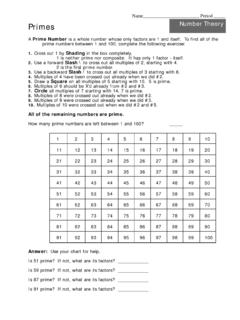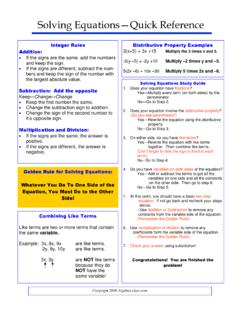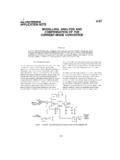Transcription of Intro to Linear Equations Math 3 6 - AGMath.com
1 Intro to Linear Equations math 3 Linear Equations : 1. y 2x 7 y x 5 2 x 3 y 12. 2. Linear Equations generally contain two variables: x and y. In a Linear equation, y is called the dependent variable and x is the independent variable. This is because y is dependent on what you plug-in for x. The domain of a Linear equation is the set of all x-coordinates and the range is the set of all y-coordinates. Examples: State the range and the domain for each set of points below. 1. (-3, -3) (-1, 1) (1, 5) (3, 9) (5, 13). 2. (-5, 8) (-2, 5) (1, 5) (4, 9) (7, 13). Practice: State the range and domain for each set of points graphed below as an inequality: Ex. #1 Domain -4 < x < 4 Range: 5 < y < 9. 4. 1. 3. 2. 5. Intro to Linear Equations math 3 Given a domain, it is easy to find the range for any Linear equation.
2 Examples: Find the range for the given domain: 1. y 2x 3 {D: -3, -2, -1, 0}. 2. y 2x 3 {D: 6, 1, -4, -9}. Practice: Find the range for the given domain: 1. y 3x 7 {D: -3, -2, -1, 0}. 2. 2. y x 1 {D: 6, 3, 0, -3, -6}. 3. 3. 2 y 6 x 10 {D: -1, 1, 3, 5}. In problems like #3 above, it helps a lot to solve for y before plugging in values for the domain. Practice: Find the range for the given domain. Begin by solving for y. 1. 2y 7 4x 5 {D: -3, -2, -1, 0}. 2. 3 y 6 9 x {D: 6, 3, 0, -3}. 3. 5 y 3 x 10 {D: x>5 }. Name_____ Period _____. Intro to Linear Equations math 3 For each graph below, state the domain and range using an inequality: 1. Domain: _____. Range: _____. 1. 2. Domain: _____. 2 3. Range: _____. 3. Domain: _____. Range: _____. 4. 4. Domain: _____. Range: _____. List the Domain and Range for each set of points listed below: 5.
3 (9,1) (8,2) (7, 3) (6, 4) (5, 5). 5. Domain: _____. Range: _____. 6. (-3, -3) (-3, -4) (-3, -5) (-3, -6). 6. Domain: _____. Range: _____. 7. y x 3 for x = -3, -4, 5, and 6. 7. Domain: _____. Range: _____. 8. y 2x 5 for x > 3. 8. Domain: {D: x > 3}____. Range: _____. Name_____ Period _____. Intro to Linear Equations math 3 Given each domain below, find the range for each equation. Solve for y where necessary. 9. y 2 x 3 {D: -1, 0, 1, 2}. 9. Range: _____. 1. 10. y x 5 {D: -4, -2, 0, 2}. 2. 10. Range: _____. 11. 3 y 6 x 12 {D: -5, -3, 1, 5}. 11. Range: _____. 12. x y 4 {D: 4, 1, -1, -9}. 12. Range: _____. 13. 3y x 6 {D: -3, 0, 3, 9}. 13. Range: _____. 14. 5 y 3x 10 {D: -15, -10, -5, 0}. 14. Range: _____. 15. 2 x y 3x 7 {D: -4, 4, 12, 20}. 15. Range: _____. Graphing A Linear Equation math 3 To graph a Linear Equation: 1.
4 Solve for y. 2. Setup a table of x and y values. 3. Plot at least three coordinates and connect them. Ex. Graph y 2x 7. Graph 2. y x 2. 3. Practice Plot each of the following Equations on the same graph. 1. y 3x 4. 3. 2. y x 5. 4. 3. y 3x 9. Graphing A Linear Equation math 3 Practice Plot each of the following Equations on the same graph. 1. x y 5. 2. 3y 2x 9. 3. 3 y 12 2 x Practice Plot each of the following Equations on the same graph. 1. 3x y 5. 2. 3 4x y 2. 3. y 5 (x 3). 3. Name_____ Period _____. Graphing Linear Equations math 3 Graph each equation below on the graphs provided. 1. y x 9 2. 3y 2x 12. 1. 3. 6x 2 y 4 4. y 3 x 6. 2. Name_____ Period _____. Graphing Linear Equations math 3 Graph each equation below on the graphs provided. 5. 4 y 11 3 x 1 6. 2x 6 3 y x 3. 7. x y 1 8. y 5 (this is the same as y=0x+5).
5 4. Standard Form math 3 Standard Form of a Linear equation: 2x y 6 3x 7 y 21 2x 6 y 1. Examples above are Linear Equations written in Standard Form. Here is Standard Form. MEMORIZE THIS. Ax By C. 1. No absolute value, exponents, square roots, etc. 2. 1 or 2 variables (A and B cannot both be zero). 3. All Linear Equations can be written in Standard Form. 4. A, B, and C are Integers (not fractions). A should be positive. Practice: Label the values for A, B, and C in each Linear equation below. 1. 2x y 6 2. 3x 7 y 21 3. x 7. Examples: Convert each equation below into Standard Form if possible. Get both variables ON THE SAME SIDE OF THE EQUATION. 1 2 3 x 5. 1. y 3x 5 2. y x 3.. 2 3 4 3 y Practice: Convert each equation below into Standard Form if possible. 3 1. 1. y 5 x 2. y x 3. x ( x 1) y 5 4. Name_____ Period _____.
6 Standard Form math 3 Convert each equation below into Standard Form. Remember to remove all fractional coefficients. 1. x y 3 2. 3y 7 2x 7 x 3. y 4. 2 x 2 10 y 4. 5. x 7 6. 2 y 12. 7. x 4y 8. 5 y 2x 2 2 4. 9. y x 4 10. 2 x y 3 5 5. 1 2. 11. x y 3 12. x y 1. 2 9. Name_____ Period _____. Standard Form math 3 Each Equation below is written in Standard Form. Solve each for y, create a table of values, and graph each. 13. x y 3 14. 6 x 3 y 12. 15. 3x y 6 16. x 2y 6. Standard Form and Intercepts math 3 On a graph, the x-intercept is where the line crosses the x-axis. The y-intercept is where a line crosses the y-axis. Practice: Look at the graphs below and give the coordinates of the x and y-intercepts. 1. 1. x-int. _____. y-int. _____. 2. x-int. _____. y-int. _____ 2. 3. 3. x-int. _____. y-int. _____.
7 Notes: The x-intercept always occurs where y equals _____. The y-intercepts always occurs where x equals _____. Set y=0 to find the x-intercept. Set x=0 to find the y-intercept. Examples: Find the x and y-intercepts of each. We will call this the coverup method. 1. 3x y 12 2. 2x 5 y 4 3. 2x 3 y 8. Practice: Find the x and y-intercepts of each. 3 2. 1. 5x 3y 30 2. x 7 y 11 3. x y 7. 4 3. Standard Form and Intercepts math 3 Practice: Each line below goes with one of the Linear Equations on the left. Match each equation with its graph by finding the intercepts. 1. 2 x 3 y 12. A. B. 2. 3 x 5 y 10 C. 3. 3x y 7. Practice: Graph each of the following using the intercepts: 1. 5 x 3 y 15. 2. 2x y 8. 3. x 3y 9. Name_____ Period _____. Standard Form and Intercepts math 3 Determine the x and y-intercepts for each equation below.
8 Convert to Standard Form where necessary. 1. x 3 y 9 2. 5x 2 y 10. x-int.: _____ x-int.: _____. y-int. _____ y-int. _____. 3. x 9y 7 4. 2x 7 y 3. x-int.: _____ x-int.: _____. y-int. _____ y-int. _____. 5. x 9 3y 6. 3y 2x 5. x-int.: _____ x-int.: _____. y-int. _____ y-int. _____. 7. y 2x 3 8. 2 x 12 4 y x-int.: _____ x-int.: _____. y-int. _____ y-int. _____. y 2 3. 9. x 10. y x 5. 3 4. x-int.: _____ x-int.: _____. y-int. _____ y-int. _____. x 9 1 2 1. 11. y 12. y x . 5 2 9 3. x-int.: _____ x-int.: _____. y-int. _____ y-int. _____. Name_____ Period _____. Standard Form math 3 Graph each equation below using the intercepts. Connect the intercepts. Intercepts are all whole numbers. 13. x 2y 6 14. 6 x 3 y 12. 15. 3x y 6 16. x 2y 10. Name_____ Period _____. Practice: Graphing Equations math 3. Graph each.
9 Remember to extend your lines to the edge of the graphs. Method 1: Find both intercepts with the cover-up method. Connect them and extend the lines. Method 2: Solve for y. Plug-in values for x to get at least three points plotted, then extend the line. Clearly label each graph with a 1, 2, or 3. 1. 2 x 5 y 10. 2. 2x y 3. 3. x 6 2y Graph each. Remember to extend your lines to the edge of the graphs. Clearly label each graph with a 4, 5, or 6. 4. y 2 x 9. 5. 2 x 7 y 14. 2. 6. y x 5. 3. Name_____ Period _____. Practice: Graphing Equations math 3. Graph each. Remember to extend your lines to the edge of the graphs. Clearly label each graph. 7. x 2y 6. 8. y 4 x 7. 1 2. 9. x 2 y 2 3. Graph each. Remember to extend your lines to the edge of the graphs. Clearly label each graph. 10. y x 7. 11. 3 x 5 y 15.
10 1. 12. y x 8. 2. Name_____ Period _____. Self-Check: Linear Equations math 3. Graph each. Remember to extend your lines to the edge of the graphs. Label each graph with a 1, 2, or 3. 1. y 2x 9. 2. 3x y 6. 2. 3. y x 6. 3. Name_____ Period _____. Self-Check: Linear Equations Graph each. Remember to extend your lines to the edge of the graphs. Label each graph with a 1, 2, or 3. 1. y 2x 9. 2. 3x y 6. 2. 3. y x 6. 3. Slope math 3 The Slope of a line is its RISE over RUN. 1. Read graphs left to right, just like sentences. 2. Find a point on the graph of a line. 3. Count how far you must go UP AND OVER to get to the next point. 4. Write this as a fraction: Ex. up 2 2. Slope . over 3 3. Examples: State the slope of each line: 1. 2. 3. Slope math 3 Slope is not always positive. Working from left to right, if you go down and over, this is negative slope.










